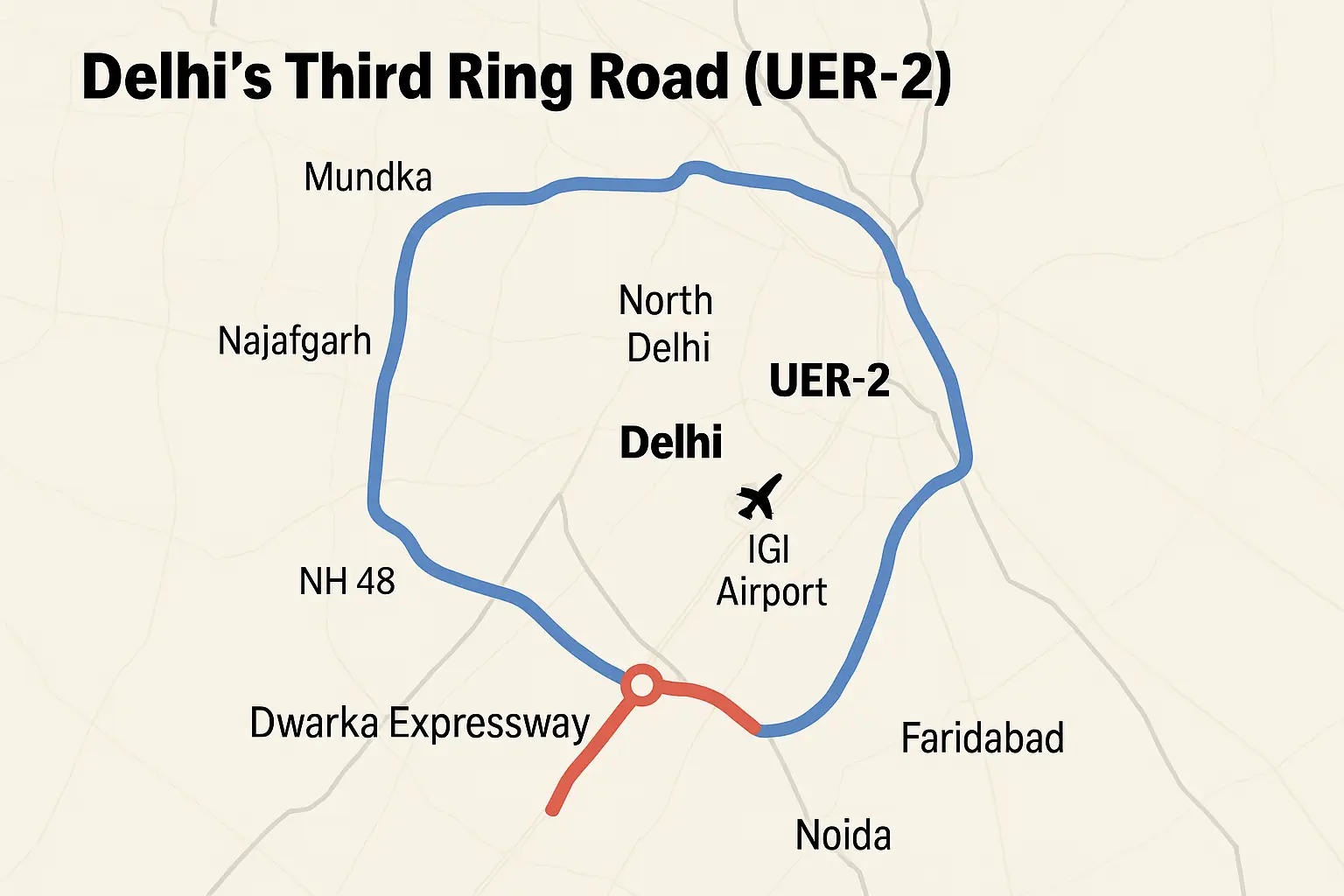In a significant leap for Delhi’s urban infrastructure, the Urban Extension Road-II (UER-2), also known as Delhi’s third Ring Road, is nearing completion and expected to open fully by August 2025. With over 95% of the construction work already completed and critical segments through Najafgarh, Mundka, and Alipur already functional, the National Highways Authority of India (NHAI) has set the final timeline for its inauguration.

Planned as a six-lane access-controlled expressway, UER-2 is strategically designed to decongest Delhi’s saturated road networks by offering an outer ring that connects the city’s peripheral zones. It will significantly reduce travel time between the Indira Gandhi International (IGI) Airport and the southwest, northwest, and border regions of Delhi and Haryana by an estimated 40–60%.
Table of Contents
A Transformational Corridor for Delhi-NCR
The UER-2 is part of a larger initiative under the Delhi Master Plan 2021 and has now been upgraded to the status of a national highway. The 76-km corridor — with 54.21 km in Delhi and 21.5 km in Haryana — is being constructed at a total cost of ₹8,000 crore. The Delhi Development Authority (DDA) is funding the Delhi section, while the NHAI is overseeing its execution.
The corridor has already started making an impact by improving accessibility in areas that were historically under-served by Delhi’s mainstream transport network. Localities like Karala, Bawana, Najafgarh, and Alipur are now more efficiently connected to key urban centers such as South Delhi, Noida, Faridabad, and national highways like NH-48.
According to a statement from the Union Road Transport Ministry, “UER-2 will create seamless linkages between Chandigarh, Gurugram, and IGI Airport, while integrating emerging urban clusters around the capital into the regional mobility framework.”
Environmental Sustainability in Focus
In a pioneering initiative, UER-2’s construction has incorporated approximately two million tonnes of legacy waste from the Ghazipur landfill, an effort that has already reduced the height of the infamous trash mountain by 7 meters. This reuse of waste — part of a broader biomining and recycling push — is a key element of the NHAI’s sustainability strategy.
Officials highlight that inert materials such as silt, construction debris, and stones have also been used in projects like the DND–Faridabad–Ballabhgarh–Sohna bypass. This not only cuts landfill waste but also reduces dependence on natural aggregates, lowers costs, and limits carbon emissions from construction processes.
Integration with the Dwarka Expressway
Further enhancing the region’s connectivity is the near-completion of the underpass section of the Dwarka Expressway near IGI Airport. This segment — expected to open in the next two weeks — links directly with UER-2 and serves as a vital bypass to NH-48.
The 28-km-long Dwarka Expressway, being built at a cost of ₹8,611 crore, is now 98% complete. Once fully operational, it will provide a swift travel corridor between Mahipalpur, Dwarka, Vasant Kunj, and Gurugram, further reducing pressure on existing arterial roads. The Delhi stretch of the expressway includes an advanced tunnel system and multiple underpasses, with completion targeted by mid-June.
Notably, Yashobhoomi Convention Centre in Sector 25, Dwarka — envisioned as a major international conference destination — will benefit from direct access via this integrated network.
Massive Investment in Road Infrastructure
Delhi-NCR is currently witnessing an unprecedented surge in road infrastructure development. According to the Ministry of Road Transport and Highways, projects worth ₹34,589 crore are underway across a cumulative span of 594 km. An additional ₹23,850 crore has been allocated for 128 km of new roads that are about to enter the construction phase.
These large-scale projects are part of a broader effort to align Delhi’s transportation systems with global urban standards while accommodating its explosive population growth and vehicular density.
Urban Planning Perspective
From an urban design and planning standpoint, UER-2 exemplifies a shift toward integrated, multi-nodal transit systems in Indian metropolises. It supports the decentralization of traffic and urban functions, redistributes development pressure from the core city, and promotes planned urban growth around ringed corridors.
As Delhi continues to sprawl, the role of such infrastructure becomes critical in ensuring efficient land use, balanced regional development, and resilience against environmental stressors. By connecting multiple nodes and reducing travel bottlenecks, UER-2 has the potential to transform Delhi’s peripheral regions into viable zones for housing, commercial activity, and logistics hubs.
What Lies Ahead
With the final touches underway and political leadership keeping a close watch on the deadlines, Delhi’s third Ring Road is on track to become a defining symbol of the capital’s infrastructure modernization. Its integration with existing and upcoming corridors — such as Dwarka Expressway, NH-48, and the Delhi-Mumbai Expressway — will significantly shape the city’s mobility patterns in the next decade.
The inauguration of UER-2 is expected to be a flagship event later this summer, marking a new era in Delhi-NCR’s road transport ecosystem — one that is not only faster and smarter but also greener and more inclusive.

When the road will be in public use from IGIA to Chandigarh road which is known as UER 2 As per news it will be inaugurated in August 2025 Is any hope for its operation for public